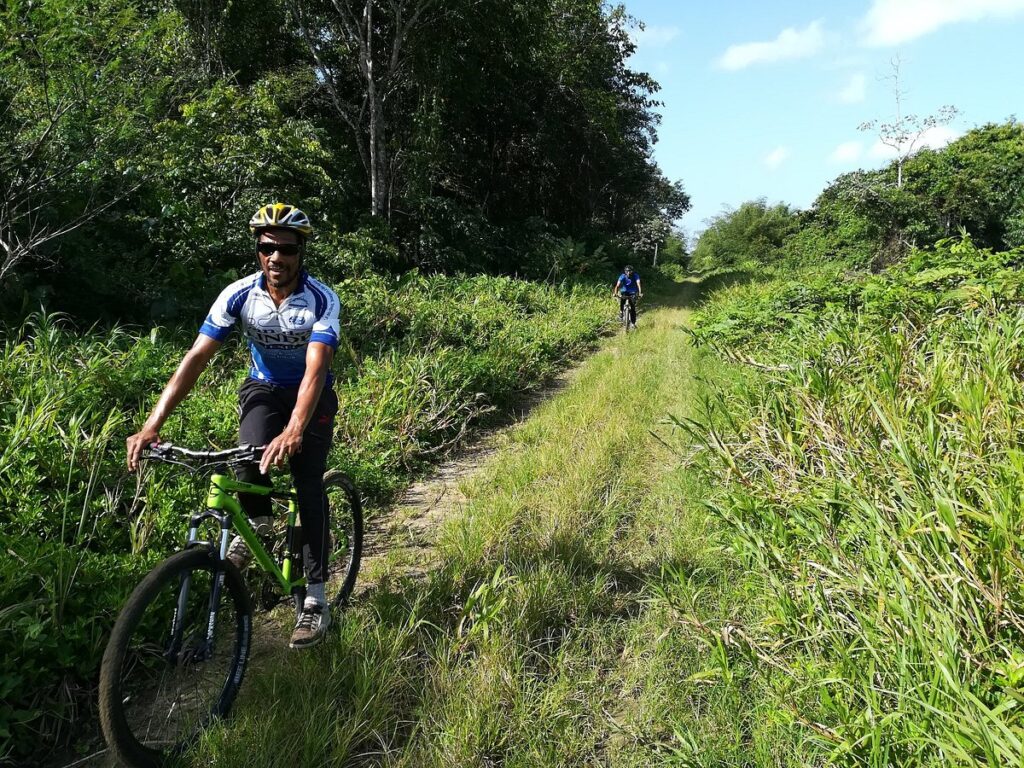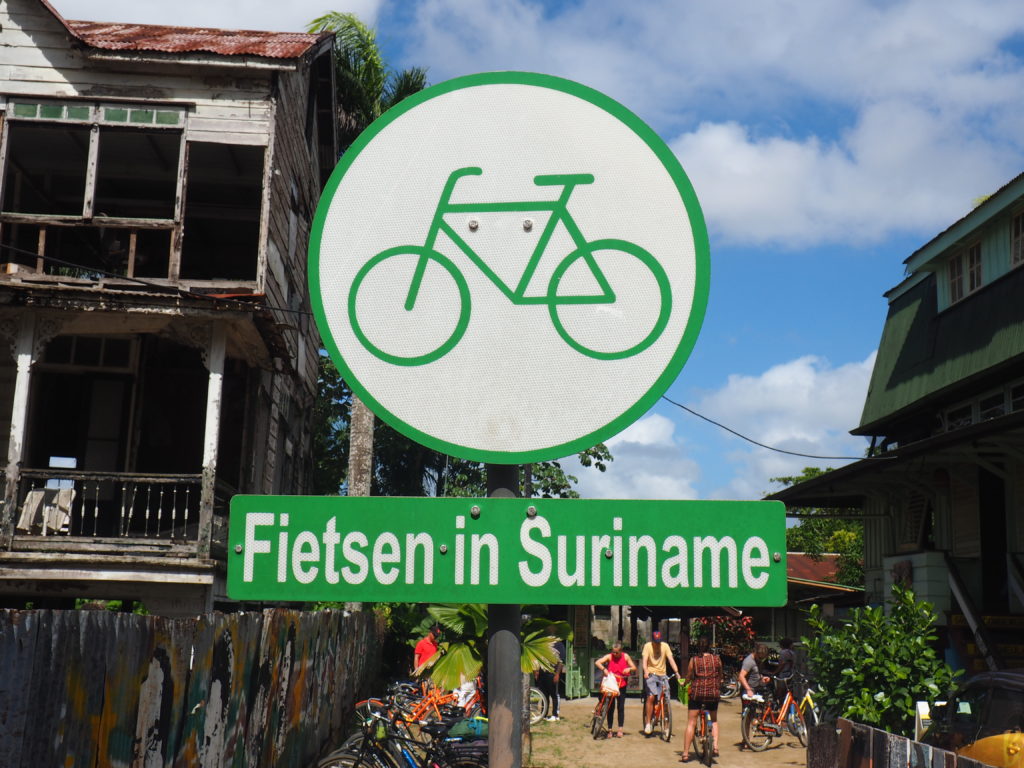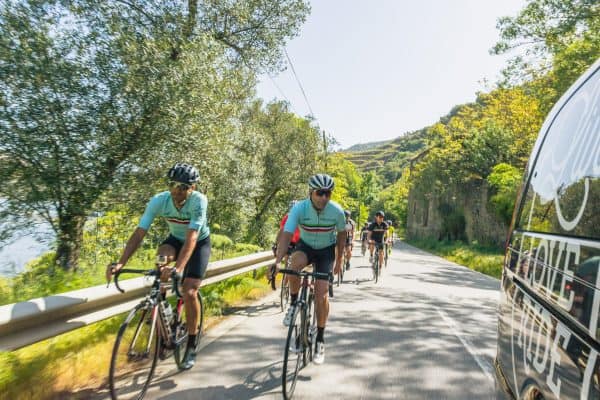Are you a biking enthusiast looking for the best cycling routes in Suriname? Well, you’re in luck because in this article, we’ll be discussing some of the top routes that you can explore on your bike. Whether you’re a beginner or an experienced cyclist, Suriname offers a variety of terrain and landscapes that will cater to your biking preferences.
Suriname, located on the northeastern coast of South America, is a hidden gem for cycling enthusiasts. With its diverse geography and stunning natural beauty, there’s no shortage of incredible routes to explore. From challenging mountain trails to peaceful coastal roads, Suriname has it all.
One of the best routes for biking enthusiasts in Suriname is the Paramaribo to Commewijne trail. This scenic route takes you through picturesque villages, lush rice fields, and historic plantations. It’s a relatively easy ride, perfect for beginners or those who simply want to enjoy a leisurely bike ride while taking in the sights and sounds of Suriname’s countryside.
For more experienced cyclists seeking a challenge, the Brownsberg Nature Park is a must-visit. Situated in the Brokopondo District, this national park offers exhilarating uphill climbs and thrilling downhill descents. The reward at the top is breath-taking panoramic views of the mesmerizing Brokopondo Reservoir.
In conclusion, Suriname is a paradise for biking enthusiasts, offering a wide range of cycling routes to suit all skill levels. Whether you’re looking for a relaxing ride through the countryside or an adrenaline-fueled adventure, this hidden gem in South America has it all. So grab your bike and get ready to explore the best routes that Suriname has to offer! Suriname, a small country on the northeastern coast of South America, may not be the first place that comes to mind when you think of cycling tours. However, this hidden gem offers a variety of scenic routes, rich cultural experiences, and untouched natural landscapes that make it an ideal destination for biking enthusiasts. Whether you’re an experienced cyclist looking for a new adventure or a casual rider seeking a unique way to explore a country, Suriname has something to offer everyone. In this article, we will explore the best cycling routes in Suriname, essential equipment needed for your tours, and tips to make your experience safe and enjoyable.

Variety of Scenic Routes
Suriname boasts a diverse range of landscapes that lend themselves perfectly to cycling. From lush rainforests to picturesque coastal areas, each route offers its own unique beauty. One of the most popular routes is the journey from Paramaribo, the capital city, to Brownsberg Nature Park. This route will take you through stunning tropical rainforests, offering breathtaking views of waterfalls, wildlife, and the Suriname River.
Another must-visit destination is the Galibi Nature Reserve. Located on the country’s northeast coast, this route provides a coastal cycling experience like no other. As you pedal along the shoreline, you’ll have the opportunity to witness sea turtle conservation efforts and visit indigenous villages, where you can immerse yourself in the local culture.
For a more leisurely ride, the Commewijne Plantation Loop is an excellent choice. This route takes you through the scenic countryside, where you can explore colonial plantations and cycle along the banks of the Suriname River. Along the way, be sure to sample some of the delicious local cuisines that Suriname has to offer.
Rich Cultural Experience
Suriname’s multicultural heritage is another reason why it is a fantastic destination for cycling tours. The country is a melting pot of ethnicities, with influences from Indigenous, African, Indian, and Dutch cultures. As you cycle through Suriname, you’ll have the chance to interact with locals from different backgrounds and learn about their customs and traditions.
It is important to respect local customs and etiquette while cycling in Suriname. Learning a few basic phrases in Sranan Tongo, the local language, can go a long way in fostering positive interactions with the indigenous communities you may encounter along your routes. Take the time to greet the people you meet on your journey and engage in conversation whenever possible. This will not only enhance your cultural experience but also help you create lasting memories.

Untouched Natural Landscapes
Suriname is home to vast areas of untouched natural beauty, making it a paradise for nature lovers. As you cycle through the country, you will have the chance to explore pristine rainforests, spot exotic wildlife, and discover hidden waterfalls. Brownsberg Nature Park is a prime example of the untouched natural landscapes Suriname has to offer. This protected area is teeming with diverse flora and fauna, offering visitors a chance to hike, swim, and even camp in the heart of nature.
The abundance of wildlife in Suriname is truly remarkable. Keep your eyes peeled for tropical birds, monkeys, and even jaguars as you cycle through the rainforests. Birdwatching enthusiasts will be delighted to know that Suriname is home to over 700 species of birds, making it a birdwatcher’s paradise.
Essential Equipment for Cycling Tours in Suriname
To ensure a safe and enjoyable cycling tour in Suriname, it is important to have the right equipment. Here is a list of essential gear you’ll need:
Biking Gear
Investing in a quality bike is crucial for a successful cycling tour. Whether you prefer a mountain bike for off-road adventures or a road bike for faster rides, choose a bike that suits your preferences and riding style. Additionally, make sure your bike is properly maintained and in good working condition before embarking on your tour.
Comfortable and padded cycling shorts are a must to avoid chafing and discomfort during long rides. A well-fitted helmet is essential for your safety, along with gloves to protect your hands and provide a better grip on the handlebars. Lightweight and breathable cycling jerseys and socks will help keep you cool and comfortable throughout your journey.
Navigation Tools
Having reliable navigation tools is essential when exploring new routes. While using a GPS device or smartphone app is convenient, it’s always a good idea to carry a physical map as a backup. Suriname’s remote areas may have limited or no cell service, so having a map can be a lifesaver if your technology fails you.
Safety Equipment
In addition to a helmet, there are other safety equipment items you should consider. Investing in a sturdy lock for your bike will give you peace of mind when you need to leave it unattended. Reflective gear, such as a vest or reflective tape, will make you more visible to drivers, especially if you’re cycling during low-light hours. A basic first aid kit and a whistle can also come in handy in case of emergencies.

Popular Cycling Routes in Suriname
Now that you know the essentials, let’s dive into the best cycling routes in Suriname. These routes are designed to showcase the country’s natural beauty, cultural heritage, and offer a memorable biking experience.
Paramaribo to Brownsberg Nature Park
Starting from Paramaribo, the capital city of Suriname, this route will take you on a captivating journey through thick rainforests and picturesque landscapes. As you leave the city behind, you’ll pedal along the Suriname River, enjoying stunning views and the serene sounds of nature.
Cycling towards Atjoni, you’ll have the opportunity to witness local communities living along the riverbanks, providing a glimpse into their daily lives. After reaching Atjoni, it’s a short boat ride across the Brokopondo Reservoir to reach the entrance of Brownsberg Nature Park.
Once inside the park, you’ll find several trails catering to different fitness levels, ranging from easy walks to more challenging hikes. The park is home to countless species of birds, monkeys, reptiles, and even the elusive jaguar. Take your time to explore the trails, cool off in freshwater creeks, and soak in the breathtaking views from the top of the mesmerizing Leo and Irene waterfalls.
Galibi Nature Reserve
For a coastal cycling experience, head to the Galibi Nature Reserve, located on Suriname’s northeastern coast. The journey starts in Albina, a border town near French Guiana. As you pedal along the coast, you’ll witness stunning views of the Atlantic Ocean and pass through idyllic fishing villages.
The Galibi Nature Reserve is renowned for its sea turtle conservation efforts. If you time your visit right, you may have the opportunity to witness the nesting and hatching of the endangered sea turtles. Experienced guides will accompany you to the nesting sites, ensuring you have a memorable and responsible wildlife encounter.
In addition to the sea turtles, Galibi Nature Reserve is also home to indigenous communities. Take the time to visit these villages, interact with the locals, and learn about their way of life. You may even have the chance to purchase authentic handmade crafts as souvenirs to commemorate your journey.
Commewijne Plantation Loop
If you’re interested in exploring Suriname’s colonial past, the Commewijne Plantation Loop is the perfect route for you. This cycling tour will take you through the picturesque countryside, passing by numerous historic plantations and remnants of Suriname’s sugar and coffee industry.
As you cycle along the banks of the Suriname River, you’ll have the chance to visit plantations such as Frederiksdorp and Peperpot. These plantations offer guided tours, giving you a glimpse into the lives of the plantation owners and the enslaved people who worked there.
Make sure to take breaks along the way to sample the local cuisine. Suriname is known for its delicious fusion of flavors, combining African, Indian, Indonesian, and Dutch influences. Indulge in dishes such as roti, pom, and bakabana, and wash it down with a refreshing glass of Surinamese-made ginger beer.
Challenges and Tips for Cycling in Suriname
While cycling in Suriname can be an exhilarating experience, it is not without its challenges. Here are some tips to make your journey safer and more enjoyable:
Navigating through Dense Forests
Suriname’s rainforests can be dense and challenging to navigate. Before setting off on your route, familiarize yourself with the trails and potential hazards. Carrying a compass or GPS device and knowing how to use them can help prevent you from getting lost.
Dealing with Humid Weather
Suriname has a tropical climate with high humidity levels year-round. This can make cycling uncomfortable, especially during the rainy season when temperatures soar. Stay hydrated by drinking plenty of water and electrolyte-rich drinks. Wearing lightweight and breathable clothing, along with applying sunscreen, will help protect you from the sun’s rays.
Staying Hydrated and Energized
Cycling long distances in Suriname’s tropical climate can be physically demanding. Pack enough water and snacks to keep yourself hydrated and energized throughout the journey. Electrolyte tablets or energy gels can also help replenish your energy levels during particularly strenuous rides.

Safety Measures for Cycling Tours in Suriname
Safety should always be a top priority while cycling in Suriname. Here are some essential safety measures to follow:
Cycling in Groups
Cycling in groups not only enhances the overall experience but also improves safety. Riding in a group makes you more visible to drivers, helps deter potential theft, and provides support in case of accidents or emergencies.
Informing Local Authorities
Before embarking on your cycling tour, inform local authorities or park rangers about your itinerary and estimated time of return. This will ensure that someone is aware of your whereabouts and can assist if needed.
Staying Alert for Wildlife Encounters
While cycling through Suriname’s forests, keep an eye out for wildlife encounters. While most animals are harmless, some may pose a potential threat. Avoid approaching or feeding wild animals, and always give them plenty of space. Familiarize yourself with the local fauna and their behaviors to ensure a safe and respectful experience.
Seasons for Cycling in Suriname
Suriname experiences two distinct seasons that may impact your cycling tour:
Dry Season (February-July)
The dry season is characterized by sunny days and less rainfall. This is an ideal time for cycling, as the roads are generally drier, and the weather is more predictable. However, keep in mind that temperatures can be hot and humid, so be prepared with adequate hydration and sun protection.
Rainy Season (August-January)
The rainy season brings frequent showers, which can make cycling more challenging. The roads may become muddy and slippery, and some trails may be inaccessible due to flooding. However, this season offers a unique opportunity to witness Suriname’s lush rainforests in their full glory. If you choose to cycle during the rainy season, be prepared with waterproof gear and expect occasional interruptions due to heavy rainfall.

Accommodation Options for Cycling Tours in Suriname
Suriname offers a range of accommodation options to suit every budget and preference:
Hotels and Resorts in Major Cities
Paramaribo, Nieuw Nickerie, and other major cities in Suriname offer a variety of hotels and resorts catering to all kinds of travelers. These establishments provide comfortable rooms, amenities, and convenient access to local attractions and dining options.
Ecotourism Lodges Near National Parks
If you prefer to immerse yourself in nature, consider staying at one of the ecotourism lodges near national parks. These lodges offer a unique experience, allowing you to fully appreciate and explore the natural surroundings. Accommodations range from basic cottages to luxurious eco-resorts, depending on your preferences and budget.
Camping in Remote Locations
For the adventurous souls, camping in remote locations is an excellent choice. Suriname’s untouched landscapes offer countless opportunities for camping enthusiasts. However, make sure to follow local regulations, obtain necessary permits if required, and practice Leave No Trace principles to minimize your impact on the environment.
Essential Cultural Etiquette for Cyclists in Suriname
Respecting local customs and traditions is essential when cycling in Suriname. Here are a few tips to keep in mind:
Respecting Local Customs
Suriname is a multicultural country with a rich tapestry of customs and traditions. When visiting indigenous villages, be respectful of local customs, beliefs, and traditions. Ask for permission before taking photographs or entering sacred areas, and always follow the guidance of your hosts.
Learning Basic Sranan Tongo Phrases
While English is widely spoken in Suriname, learning a few basic phrases in Sranan Tongo can help you connect with the locals on a deeper level. Taking the time to learn simple greetings and expressions will be greatly appreciated and show your respect for the local culture.
Interacting with Indigenous Communities
Suriname is home to numerous indigenous communities, each with its own unique culture and way of life. When visiting these communities, engage respectfully with the locals. Ask questions, learn about their traditions, and purchase handicrafts to support the local economy.
Exploring the Local Cuisine During Cycling Tours
No cycling tour is complete without indulging in the local cuisine. Suriname offers a tantalizing array of dishes that reflect its multicultural heritage:
Traditional Surinamese Dishes
Don’t miss the opportunity to savor traditional Surinamese dishes such as roti, a beloved Indian-inspired flatbread served with curries, and pom, a mouthwatering oven-baked dish with marinated chicken or fish and root vegetables. Other must-try dishes include snesi foroe (deep-fried fish), moksi alesi (a flavorful rice and beans dish), and saoto soup (a delicious broth-based soup).
Sampling Exotic Fruits
Suriname is renowned for its exotic fruits. From juicy mangoes and aromatic papayas to sour sop and passion fruit, the country offers a wide variety of flavors for you to explore. Be sure to visit local markets and fruit stands to sample these delectable tropical treats.
Local Street Food Delicacies
Suriname’s street food scene is vibrant and diverse. As you cycle through the cities, indulge in popular street food delicacies such as bara (a deep-fried dough with spicy toppings), broodje pom (a sandwich filled with pom), and loempia (Surinamese version of spring rolls). Wash it all down with a refreshing glass of Surinamese-made ginger beer or dawet, a sweet coconut milk drink.
Embracing Ecotourism and Sustainability
Suriname’s pristine environment is a precious resource that must be protected for future generations. As a responsible cyclist, there are steps you can take to minimize your impact on the environment:
Responsible Waste Management
When cycling through Suriname, dispose of your waste properly. Carry a small trash bag with you and dispose of it in designated containers. Avoid littering, as this can harm wildlife and damage the natural beauty of the country.
Supporting Local Communities
Supporting local communities is an essential part of sustainable travel. Purchase handicrafts directly from artisans, dine at local eateries, and engage with local guides and tour operators. By doing so, you contribute to the local economy and support the preservation of Suriname’s cultural heritage.
Choosing Eco-Friendly Accommodations
Consider staying at eco-friendly accommodations that prioritize sustainability and minimize their environmental footprint. Many lodges and resorts in Suriname have implemented initiatives such as energy conservation, waste reduction, and water-saving practices. By choosing these accommodations, you support their efforts in preserving Suriname’s natural beauty.
Conclusion
Cycling tours in Suriname offer a unique and unforgettable way to explore this hidden gem of South America. With its variety of scenic routes, rich cultural experiences, and untouched natural landscapes, Suriname is a dream destination for biking enthusiasts. From the breathtaking views of Brownsberg Nature Park to the coastal beauty of Galibi Nature Reserve and the cultural immersion of the Commewijne Plantation Loop, Suriname has something to offer everyone.
By equipping yourself with the essential gear, respecting local customs, and embracing ecotourism and sustainability, you can have a safe and memorable cycling experience in Suriname. So, hop on your bike and discover the hidden gems of this remarkable country, creating lasting memories along the way.